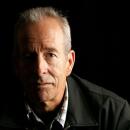Live review: Roger Waters and ‘The Wall’ at Staples Center
- Share via
This article was originally on a blog post platform and may be missing photos, graphics or links. See About archive blog posts.
Everyone else in the music business may be content to think smaller these days.
Not Roger Waters.
Pink Floyd’s erstwhile lead singer and songwriter not only remembers when rock music could also function as grand-scale theater, he helped arrange that whole marriage.
In an era in which grand-scale ambition at times seems to be diminishing hand in hand with record sales, Waters wants to perpetuate the notion that rock can offer not just eye-boggling spectacle, which has become the alpha and omega of so many of today’s big-budget pop-R&B concert tours, but spectacle coupled with equally big ideas.
So Waters, 66, has resurrected his old band’s 1979 opus in excelsis “The Wall” for a new generation, and Monday at Staples Center, at the first of five Southland performances over the next few weeks, he made it bigger, broader, harder, louder and more dazzling than ever. And that was just the first two pyrotechnics-heavy minutes.
But neither Waters nor “The Wall” offered much in the way of nuance to begin with.
It’s a brooding, blaring, fiercely proud wallow through the roots of youthful fear, anger and alienation, one that touched a deep nerve with legions of listeners. You have to believe most of them let its dark themes unfurl in the privacy of their bedrooms where they sat alone, late at night, probably in the dark.
All the lonely people, however, ultimately formed a global nation of their own, pushing “The Wall” over the last three decades into a tie for third place (with “Led Zeppelin IV”) on the Recording Industry Assn. of America’s list of the biggest selling albums of all time, logging a comfortably mind-numbing 23 million copies in the U.S. alone. (Only Michael Jackson’s “Thriller” and the Eagles’ “Their Greatest Hits/1971-1975” have outsold it, with 29 million copies each according to the RIAA.)
Waters has said in recent interviews that he’s come a long way from the fearful 36-year-old he was when he wrote most of the songs for the album. But whatever he’s gained in the way of self-understanding hasn’t softened his hammer-over-the-head way of putting a message across.
As an idea man, Waters is as subtle as a goose-stepping mallet, one of many blatant images of a monolithic and militaristic society that flashed on the literal wall that was erected out of what looked like giant cardboard Duplos across the broad Staples stage as the performance unfolded.
“The Wall,” then and now, is the Who’s “Tommy” without Pete Townshend’s poetry, or most significantly, his wicked sense of humor.
But it was obvious long ago that Waters will embrace subtlety and ambiguity when pigs fly -- and yes, the flying pig is back, this time painted black and decorated with slogans suggesting Russian propaganda as it floated ominously by remote control through the arena.
There’s no denying that this staging of “The Wall” is as visually striking, especially the two-story tall inflated marionettes representing three key characters in the story, as it is musically lush. Indeed, Waters’ saving grace is his hauntingly melodic, often elegant, periodically funky rock music, which he delivered on Monday with precision and chest-rattling force with backing from a committed squadron of six instrumentalists and five singers. Absent that music, “The Wall” would simply be a screed of left-wing agitprop that rounds up the usual suspects to rail against: rampant commercialism, militarism and societal indifference to the suffering of its least powerful members.
But the narrative of the rock opera, in being expanded to further point up the connection Waters wants to make between individual fear and societal dysfunction, periodically gets lost in the shuffle.
The strong autobiographical elements of the original concept album -- tracing Waters’ birth in England at the tail end of World War II and the death of his father in Italy during the war, which resulted in all sorts of psychological trauma for the fatherless boy-turned-tortured-rock-titan -- are muddied in the playing out of Waters’ understandable antiwar position.
In the new production, that takes the form of names and biographical details of dozens upon dozens of people killed in various wars around the world, also projected onto the titular wall. He also employs footage of children being reunited with their soldier parents, a tact both moving and manipulative. The destruction of the wall that symbolizes an emotional breakthrough, brings the whole thing to an undeniably impressive climax.
Few would argue with Waters’ overarching message that war and fear are quagmires that are best avoided. But he makes it hard for a thinking person to get past the ham-fisted way he often expresses that message.
And yet. And yet. Despite the sometimes awkward and bellicose tone of “The Wall,” as the godfather of rock critics Robert Christgau once so aptly wrote, “For a dumb tribulations-of-a-rock-star epic, this isn’t bad.”
That was then. Now it’s the tribulations of a war-weary, corporate greed-despising member of what Mark Twain gleefully called “the damned human race.” And still, it’s not bad.
‘The Wall’ continues Tuesday and Sunday at Staples and concludes its U.S. tour leg on Dec. 13 and 14 at the Honda Center in Anaheim.
-- Randy Lewis
